The real estate industry is only one of the many industries artificial intelligence (AI) has changed. AI is becoming a vital tool for real estate agents, investors, buyers, sellers, and other stakeholders due to its capacity to analyze enormous volumes of data, automate procedures, and offer insightful analysis.
However, there’s still an unanswered question going on for a long time: will AI replace realtors and their services? The short answer is no.
Instead, AI complements what they offer, thus providing a positive effect on both the real estate industry and customers.
The capacity of AI to process and analyze enormous volumes of data is one of its most important benefits in the real estate industry.
AI algorithms can be used by real estate brokers to gather and evaluate demographic data, property data, market trends, and other pertinent information. They obtain important knowledge about pricing, demand trends, investment possibilities, and property comparisons by doing this.
To determine a property's fair market value, artificial intelligence can gather enormous volumes of data from a variety of sources, including past transactions, the characteristics of the property, and the state of the market.
AI-enabled tools can spot developing markets, forecast changes in real estate values, and make data-driven investment choices. Artificial intelligence can be useful in predicting future trends in the residential and commercial real estate markets, even though it is not a crystal ball.
Platforms with AI capabilities have greatly enhanced the home-search experience for investors and buyers alike. These services generate individualized property recommendations based on local data, historical trends, and user preferences through machine learning algorithms.
To make the process of finding a property easier, artificial intelligence can consider a variety of aspects, including location preferences, desired amenities, budget, and more. For buyers, investors, homeowners, and even real estate brokers helping their customers, this new technology saves time and effort.
AI is not the enemy in real estate. Artificial intelligence can be a huge asset in giving investors, house sellers, and purchasers a more accurate and tailored experience. Furthermore, artificial intelligence can be used by real estate firms to customize their services to meet the unique needs of each customer.
The way properties are marketed using augmented reality (AR) and virtual reality (VR) technologies has been completely transformed by artificial intelligence. By using virtual tours, potential investors and purchasers can inspect homes from a distance, which can save time and money.
Using floor plans and other information, AI technology can also create 3D models and renderings of properties, providing investors and buyers with a realistic representation of the area. Before in-person visits, this immersive experience helps you refine possibilities and make educated judgments during the home hunt.
When looking for a home in a new real estate market, prospective buyers from out of state can benefit greatly from virtual tours. While taking a virtual tour of the property cannot substitute seeing it in person, AI can assist prospective buyers learn about the essential features of the house.
Accurate property pricing is essential for real estate agents and sellers. To identify the best pricing tactics, AI algorithms can examine past data, market trends, property features, and regional considerations.
Before the development of artificial intelligence, property values were manually determined using data from previous sales in the area. However, AI in real estate can produce more accurate property prices, benefiting both buyers and sellers, thanks to machine learning and predictive modeling.
Real estate experts and agents may forecast property demand, find possible buyers, and suggest competitive prices by leveraging predictive analytics technologies. Sellers can improve their listings, draw in more potential customers, and close deals more quickly with the help of AI-powered pricing tools.
AI is automating a lot of the work in property management and making it more efficient. Intelligent systems are capable of optimizing building operations, detecting maintenance difficulties, and monitoring and controlling energy consumption. This not only saves money but also makes the occupants happier.
AI-powered software simplifies administrative work, keeps track of lease agreements, oversees maintenance, and offers individualized tenant services to real estate brokers handling numerous properties.
These astute technological developments free up professionals' time and resources so they can concentrate on higher-value tasks.

Although artificial intelligence (AI) has great promise for the future of many industries, including real estate, it is unlikely to displace the real estate industry entirely for several reasons.
Complex decision-making procedures involving real estate transactions call on human judgment and experience.
Artificial Intelligence (AI) might be able to evaluate data and offer insights, but it is unable to comprehend the complex desires and feelings of consumers and sellers. AI cannot easily replace the individualized counsel, bargaining skills, and recommendations that real estate brokers provide.
Property transactions are frequently emotional and private affairs. Consumers like the personal touch and credibility that real estate brokers provide.
An AI system won't be able to build the same kind of connection or offer the emotional support that customers frequently need in these kinds of interactions.
The real estate markets in different places differ significantly. Real estate brokers are extremely knowledgeable about local amenities, zoning laws, market trends, and particular communities.
To give clients reliable counsel and guidance, localized expertise is essential. Without access to complete and current data, AI systems may find it difficult to reproduce this expertise.
Outstanding communication and negotiating abilities are necessary while negotiating the parameters of a real estate transaction. Real estate brokers are skilled negotiators who can speak up for the interests of their clients.
Even if AI is capable of using data analysis to recommend negotiation tactics, it might not have the interpersonal abilities needed to handle difficult discussions.
Both substantial financial outlays and legal requirements are present in real estate purchases. Real estate brokers are frequently relied upon by clients to guarantee a seamless and compliant transaction.
Real estate agents have a fiduciary commitment to their customers. This entails controlling any risks, maintaining confidentiality, and safeguarding their interests. In these transactions, the human aspect fosters confidence and establishes accountability.
Artificial Intelligence (AI) has revolutionized the real estate industry, offering advantages to consumers, sellers, investors, and professionals alike.
Artificial intelligence (AI)-powered technologies have completely changed the real estate industry, from data analysis and market insights to virtual tours and predictive analytics. Even if artificial intelligence (AI) makes decisions easier, increases productivity, and streamlines procedures, it is unlikely to completely replace the function of real estate experts.
After all, nothing beats an amazing real estate agent.
Have you had your house up on the market for a long time, but you're not getting many responses from potential buyers? If yes, you might find yourself wondering why your house isn't selling."
More often than not, the financial aspect of the transaction has a greater influence on why a house stays on the market longer than anticipated.
According to data from the Federal Reserve Bank of St. Louis (FRED), houses in the US were on the market for a median of 43 days as of May 2023. Compared to the June 2021 purchasing frenzy, when homes were on the market for a median of just 35.5 days, this is a modest uptick.
Numerous factors, including alterations in buyer behavior, variations in inventory levels, and variations in property prices, could be responsible for this trend.
In this post, we will talk about the usual causes of why your home is not selling and provide expert tips on how to make things better.
It's normal to be concerned if your house isn't selling as soon as you want, as selling a house is a big undertaking.
When your home is for sale, keep an eye out for these crucial indicators that suggest it may be time to get concerned:
Above Average Days On Market: You should be concerned if your house has been on the market for a longer period than the median days on the market that your neighborhood is currently seeing. The average number of days that US properties were listed for sale was 43 as of May 2023. It may be time to reconsider your approach if your house has been on the market for a longer time than this without drawing any solid offers.
Changes in Home Prices: If the value of homes in your neighborhood is dropping and the price you have set for your house is based on earlier, higher values, prospective buyers may think it is too expensive. The median price of a home has decreased somewhat in 2023.
Consistently Negative Feedback: If prospective buyers are consistently commenting negatively on certain features of your house, such as the design, condition, or asking price, this may indicate that adjustments need to be made.
Few Showings or Low Online Interest: If your home isn't having many showings or if there isn't much interest being generated by the online listing, that's another indication that you should be concerned. This may mean that buyers aren't finding your house appealing for whatever reason—it might be the pricing, the quality of the images, or the marketing strategy used.
A property's saleability is influenced by a wide range of elements in the dynamic real estate market. These factors may include an expensive listing, a slow real estate market, the need for renovations, insufficient advertising, or even the absence of a knowledgeable real estate agent.
Additionally, external factors such as economic trends, mortgage rates, and seasonal swings might also play an impact.
Here are some reasons why your home might not be selling:
A significant portion of prospective buyers will not be interested in your home if it is priced higher than they would expect for the neighborhood. You must conduct some study to determine whether your home is too expensive or not.
To find out what comparable properties have sold for in your community, check up recent sales. This is a good estimate of the worth of your home if you can locate a recently sold home in your community with comparable square footage, number of bedrooms, and number of bathrooms. Working with your real estate agents and asking relevant questions can help, too.
The best course of action, if your home has been overpriced, is to reduce the price to closely match the properties in your neighborhood. This can make your house appeal to more purchasers and have a higher chance of selling.
Potential purchasers may be turned off by your home's need for repairs unless you are specifically offering it as an as-is fixer-upper. Make sure to address any significant problems, such as leaks, cracks, or holes in the walls, before listing your house for sale. It's advisable to think about doing some aesthetic adjustments, such as repainting the walls or changing the fixtures.
By making these adjustments, you'll attract more purchasers and expedite the sale of your house.

Home prices are declining and property markets are cooling across the US. This can be a major factor in the failure of your house to sell.
It could take longer for your house to sell if the local real estate market is sluggish, especially if you're not getting the price you want. Although you frequently have little influence over this, you still have choices.
In a weak market, you can assist sell your house by lowering the listing price, providing incentives, or being flexible with the closing date. Another option would be to rent out your house while you wait for the market to improve.
It's possible that your house isn't selling because you didn't take the time to stage it for pictures and showings. The speed at which your house sells may be impacted by the staging you do.
It will be challenging for purchasers to appreciate the potential in your house if it is disorganized or unkempt.
Before marketing your house, make sure to thoroughly clean and clear it. You should also consider hiring a professional stager to assist you arrange furniture and décor in a way that is attractive to the eye.
Your home will appeal to more buyers and have a higher chance of selling quickly if you take the time to prepare it appropriately.
Your home may take longer to sell if it is in a poor neighborhood. Although you normally have little control over this, there are some things you may do to lessen its impact.
Keeping up with the upkeep of your house is one thing you can do. This will increase its appeal to buyers and help it stand out from other houses in the neighborhood. In your listing, make sure to emphasize any advantages the location may have. Mention things like how close your house is to parks or reputable schools.
Even though you are unable to relocate your house, there are still things you may do to improve its appeal to potential purchasers.
When a prospective buyer pulls up to your house, they will first notice the exterior. Buyers may be put off by your house's unattractive outside before they ever enter.
Organizing the yard is the first step in increasing curb appeal. Trim the lawn and get rid of any dead plants or weeds. To give a pop of color, you should also think about adding some potted flowers or plants.
Next, shift your focus to the exterior of the house. If required, pressure wash the siding and clean the windows and doors. These small adjustments can have a significant impact on how buyers find your house.
The majority of purchasers in today's digital environment begin their search for a home online. This implies that the images of your house are crucial. Buyers will be turned off by dark, grainy, or oddly angled images and will be less inclined to come to view your house in person.
Ensure working with a professional photographer to get stunning images of your house. The nicest aspects of your house should be highlighted in these pictures, making it appear as welcoming as possible.
A buyer's first thought when viewing an outdated-looking home is probably going to be extensive upgrades. That alone is enough to bring to mind visions of an enormous undertaking with an expensive price tag.
There are a few things you may do to update the style of your property if it isn't very appealing to purchasers. Modernizing the hardware and fixtures around the house is one thing you may do. This covers hardware such as cabinet knobs, light fixtures, and door handles.
You might also try painting the walls or changing out the flooring. Although these modifications may cost more money and time, they can significantly update your house and increase its buyer appeal.
These are reasonably priced improvements that can significantly alter the way your house looks overall.
These are just some of the reasons why your home might not be selling. In the second part, we'll talk more about this and help you address them so you can sell your property quickly.
Having an additional bathroom in your home can seem like a luxury, particularly if you have a growing family or are having overnight guests.
However, not every shower is made equal. Walk-in, stall, and corner showers conserve space, although they may need compromises.
Think about the sacrifices you might need to make to maintain cleanliness in small spaces, whether you're putting one in a brand-new bathroom or simply thinking about adding one to an already-existing half bathroom.
In a corner shower, even the stylish bathers may get a sense of the glass walls closing in on them. For walk-in showers, it's generally recommended that they provide at least 36 by 36 inches of area. Anything smaller could make you feel a little cramped.
Standard prefab shower kits are well-liked since they don't take up a lot of room and are reasonably priced. Their sizes usually vary from 31 by 31 inches to 36 by 48 inches.
Look for a showroom with models you can enter to determine whether there will be enough space for you to feel comfortable taking a shower before making a decision. But don't just enter and act like you're taking a shower.
Ask yourself: is it easy to reach everything?
Find out if you can bend or stretch comfortably.
If you have a problem doing any or all of these, it’s time to re-evaluate the space of your bathroom.
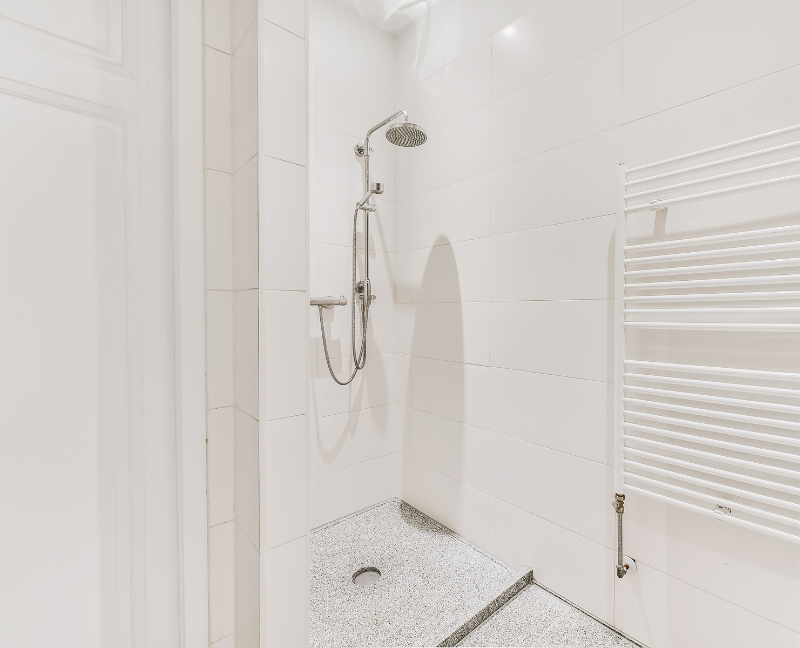
Having an additional shower might increase your property's value, but there’s no guarantee of that.
Many homeowners believe this – that adding more showers can have a positive effect on the property’s value. However, that relies on the buyer whether they like this or not. There’s no use adding a shower if it’s not going to be utilized.
Therefore, there's a strong possibility you'll be adding value if, for example, you add a brand-new stall shower to a master bedroom that didn't have a master bath and the other homes in the neighborhood don't have one either.
Adding a stall shower to a powder room off the kitchen or in the basement, on the other hand, might not be something buyers will use frequently enough or see the benefit of having.
Consider whether the amount you are spending will yield a return on your investment, just like you would with any home repair, and get the advice of a reputable real estate agent for their perspective.
However, it's not always about turning a profit on a home upgrade. Sometimes the upgrades are just made to make your house more enjoyable. Install and enjoy once you've figured out it's the perfect fit for you and your home, both literally and figuratively!
The living room is frequently called the "heart" of the home, and there is a good reason for this perception. It is the focus for friends and family get-togethers and fulfills several functions. A friendly and well-arranged living room may create an excellent first impression on visitors and help them feel at home.
The living room has many uses because it is such a flexible area. Its design and decor affect the home's overall appeal. A well-planned living room may give the entire home feel cozy, while a poorly constructed one does the opposite.
There are many things you can do in the living room, which can also serve as a workspace, a reading area, or a music room. Thus, giving it the right attention as well as an upgrade is always a good idea. Here are ways how to make this room more welcoming and elegant.
A lighting source, whether it be a floor, table, or ceiling lamp, may also make a statement. Consider using dramatic lighting accents like large lampshades, a glitzy gold lamp base, or a contemporary crystal chandelier. A space can have a high-style focal point with a shining finish or an enormous size.

The brass chandelier and table lamps in this room lend the black-and-yellow color scheme a striking, opulent radiance.
Budget Tip: Budget-friendly glamorous lighting choices are undoubtedly possible. You may find crystal ceiling fittings that cost less than $200. For elegant floor and table lamps, check big-box stores for striking designs that cost less than $100.
Mirrors are the ideal piece of furniture to add light, create the appearance of greater space, and give off a glitzy, luxurious vibe. A huge mirror over a sofa, credenza, or focal point, like a fireplace, should be hung.

In this white living room, a collection of simple, large mirrors creates a chic background for the white couches. It gives just the appropriate amount of glitz without giving the room the appearance of an ostentatious jewel box.
Budget Tip: Oversized mirrors don't need to be elaborate to look opulent. If a large mirror isn't available, consider clustering smaller mirrors to achieve a like look.
The larger the canvas or framed piece of art in the living room, the more upscale the space will appear. Large artwork gives an expensive-looking gallery appearance.

A regular white cabinet in this room becomes the focal point of the room thanks to a giant artwork painted in metallic gold. The striking black lamp adds even more drama to the wall.
Budget Tip: It can be difficult to choose affordable art that has a high-end appearance. It's challenging since art is individualized and subjective. Look through your local flea markets or online marketplaces like Chairish and Etsy for reasonably priced solutions. A huge original painted canvas or framed print usually looks more upscale than a giclée or printed canvas. Your living space can have a gallery-like atmosphere by using basic shapes and forms that you like, that provide drama, or a flash of color.
Your space will appear larger with a rug that can comfortably fit beneath all of your key pieces of furniture, including the coffee table, sofa, and armchairs. When trying to elevate the standard of design and elegance in a living room, this is crucial.

This area's huge carpeting highlights every piece of furniture. Its vastness allows the eye to move about and take in the room's expanse, which includes the colorful pouf and chic accent chair. This is how the room would appear if there was just a tiny rug beneath the coffee table. A modest size would resemble a bath mat and give the impression that the room is smaller.
Budget Tip: While sisal and jute are natural fiber carpets, they might be more affordable than large rugs. To give them a softer feel, they are occasionally woven with other materials. As an alternative, search for cozy-textured indoor-outdoor rugs.
Hang window coverings from the ceiling or as high up on the wall as you can. Elevated placement, a common characteristic in luxury living rooms, adds volume and offers the illusion of a higher ceiling.

Budget Tip: If you can't afford pricey curtain panels, you may still give your space a more upscale appearance by hanging more of them, or doubling up on the panels. Most curtain materials appear more opulent when they have thicker bunched panels. You can also hide any subpar detailing or quality in your drapes by doubling the number. Even less expensive curtains typically look more expensive when they have a consistent hue and some texture.
It is possible to make your living room feel more inviting and comfortable without spending so much. All you have to do is add in a little creativity along with research.
As always, you can check our website to see more design inspirations.
Imagine spending a hot day reading a book or sipping a beverage while relaxing by your own swimming pool. Meanwhile, the children, laughing and playing on their pool floats or practicing their dive.
Having a pool at home has long been considered a perk that only elites usually have. However, while others see it as essential, others think it's a deal-breaker.
To find out if installing an in-ground pool is worth it or not, especially if it's the best way to boost home value, make sure to read the entire post.
In the meantime, if you want to know how to boost the value of your home, here are some other free resources:
In-ground pool owners may anticipate a 56% return on their investment, according to the National Association of REALTORS® Remodeling Impact Report: Outdoor Features for 2023.
When it's time to sell, your home's worth may rise by a maximum of 7%, according to HouseLogic. However, that all relies on several different things, such as:

The report stated that landscape experts calculated the price of constructing an in-ground pool to be $90,000. A conventional filtration system, three to seven feet of depth, and walls made of gunite (a mixture of sand, water, and cement) are included in the price mentioned. The pool measures eighteen by thirty-six feet.
The cost of installing an inground pool can range from $80 to $250 per square foot, or a total of $25,000 to $100,000, depending on its size and material. Not to mention, tailored renovations or additions will incur additional costs, such as lighting, a diving board or slide, a heater, and landscaping.
Additionally, to keep kids and pets safe around water and to prevent accidents, the majority of jurisdictions mandate the installation of safety elements including covers, enclosures, and fences. For example, the cost of pool fencing alone might range from $5,000 to $15,000.
Sanitation is necessary to keep bacteria and germs under control in your swimming pool, regardless of its style or composition. In order to maintain the right pH, alkalinity, and calcium levels, the water must also be balanced. These are just a few of the annual and monthly expenses that come with owning a swimming pool and can affect its value.
A pool structure is usually covered by a normal home insurance policy without the need for a separate rider. However, if you intend to build a pool on your land, think about speaking with your insurance provider about how having a pool can impact your premiums and raise your liability coverage. Furthermore, if you fail to install a pool fence, your insurance may refuse to cover your pool and your liability claim in the event of an accident occurring in your pool.
While installing a pool may raise your yearly property taxes in some places, it may not affect how much your house sells for.
The only person who can accurately assess the return on investment of a luxury purchase like a swimming pool is you, the homeowner. Whether it improves your quality of life by providing a space for leisure, relaxation, and memorable occasions is up to you to determine.
According to the NAR Remodeling Impact Report, homeowners who added a pool reported a "joy score" of 10 on a scale of 1 to 10, suggesting that the addition significantly affected their sense of satisfaction and achievement following the project's completion. Additionally, after adding an in-ground pool, at least 90% of respondents said they enjoy their time at home more. That can be difficult to quantify.
You live here at the end of the day. Go ahead, jump in, and enjoy the swim if you intend to establish roots, have the funds, and have thought through the advantages and disadvantages of building a pool.
Many people have false beliefs about leading an eco-friendly lifestyle, especially the notion that it's costly, difficult, and calls for a full head of dreadlocks.
Being green really isn't that hard; all it takes is one small adjustment at a time to benefit the environment.
And here's the huge bonus: You may frequently save money by implementing these tiny lifestyle adjustments.
Here are the eco-friendly tips for home that can help save money:
For most homes, energy costs represent a considerable monthly expense, and domestic energy use significantly contributes to environmental problems. Improving energy efficiency can substantially lessen your influence on the environment and electricity costs. Still, some of these improvements require much effort and money.
In addition to discounted costs for energy-efficient upgrades and appliances, several utility providers now give free energy audits and rebate programs. Look for deals you can take advantage of by first visiting the websites of your gas and electric suppliers. In addition, you can determine if you qualify for any federal income tax credits associated with energy conservation.
After exploring these promos and incentive programs, inventory your home for energy efficiency improvements and investigate low-cost renovations to reduce energy consumption:
Summer may be filled with more activities compared to other seasons, so it might require an effort to find enough time to clean, organize, and refresh your home. After all, doing so has environmental, financial, and even mental benefits for you and your family.
Here are some ideas for recycling, reusing, and reducing items that are already in your home:

There are many cheap, eco-friendly things you can do on your lawn that could have a beneficial impact on your finances and the environment, such as:
Plastic water bottles that are only used once are extremely wasteful and harmful to the environment.
Three times as much water is needed to make one water bottle as there are in one due to the plastic production process, yet an estimated 80% of them are not recycled!
Regretfully, they wind up in landfills or the ocean since individuals frequently neglect to recycle them correctly.
Purchasing a reusable, appropriately sized water bottle will solve this issue and allow you to carry it with you everywhere you go.
Long-term cost savings are also achieved by reusing water bottles since fewer plastic bottles will need to be bought.
Reducing your meat intake can actually have a significant positive impact on the environment.
Livestock operations occupy more than thirty percent of the Earth's surface.
In line with a UN research, “the livestock sector accounts for 9 percent of CO2 deriving from human-related activities, but produces a much larger share of even more harmful greenhouse gases. It generates 65 percent of human-related nitrous oxide, which has 296 times the Global Warming Potential (GWP) of CO2.”
Reducing your meat intake is a significant step in lowering your total GWP gas emissions.
We can enjoy and use more land for pleasure when there are less cattle on it.
Think about eating more fish or substituting veggies for some of your meat-heavy meals!
First of all, you don’t have to completely get rid of your paper towels; however, use them sparingly as much as you can.
Comparing the seven most popular ways for drying hands, researchers at Massachusetts Institute of Technology (MIT) discovered that using paper towels results in 70% more carbon emissions than using hand dryers with cold air.
Even though you most likely don't have a hand dryer at home, drying off with a cotton towel is 48% more environmentally friendly than using a paper towel.
When the time comes for your spring cleaning, chop up an old t-shirt and use it as a cloth instead of buying a dozen rolls of paper towels.
Since you were going to discard it anyhow, why not make financial and environmental savings simultaneously?
Gather all of your used rags into a basket and give them a quick wash.
Reuse, reuse, reuse!
Light switches are beside the door for a reason!
Turn them off whenever you leave a room, and especially when you leave the house. This will help you save energy and money on your energy bill.
Your ability to save energy by shutting off the lights will vary depending on the kind of bulbs you use.
An incandescent lightbulb is among the least energy-efficient forms of illumination available.
Just 10% of the energy used by incandescent light bulbs is converted to light; the remaining 90% is wasted as heat.
Therefore, you can save more energy in your home by turning off your incandescent light bulbs.
Since halogen lights employ the same technology as incandescent light bulbs, turning them off when not in use can also help cut energy bills.
It is also necessary to turn off compact fluorescent lights, or CFLs, according to the usual rule of thumb.
If you plan to be back in your room in fifteen minutes, you can leave the lights on.
But turning them off is more energy-efficient if you leave your home for longer than fifteen minutes.
Your CFL bulbs' lifespan will also be increased by using this technique.
Nevertheless, turning on or off Light Emitting Diodes, or LED bulbs, will not have an impact on them.
One of the key features of LED bulbs that makes them perfect for energy conservation at home is this.
Additionally, you can use sensors to turn them fully on and off instantaneously and to turn them on and off automatically.
Other than this, unplug appliances when you’re not using them.
Want more tips on taking care of your home and living an eco-friendly lifestyle? Why not check our free resources by clicking this link.
Are you ready to upgrade your kitchen into a haven for anybody who enjoys cooking? If yes, do not look any further!
If you're considering renovating your kitchen, you should know what styles are trendy right now for this room that serves as the center of your home. Whether you want to make significant changes to your kitchen or a few adjustments, these creative renovation kitchen ideas will motivate you to think outside the box.
Here are nine renovation kitchen ideas you can think of if you want to upgrade your kitchen:
In recent years, many homeowners are choosing to open up the space in their kitchens. An entirely open-concept kitchen, where no wall divides the kitchen from an adjacent space, is the preferred design for 64% of homeowners remodeling their kitchens. Enhancing entertainment potential and increasing functionality are the two most often mentioned reasons for designing an open-concept area.
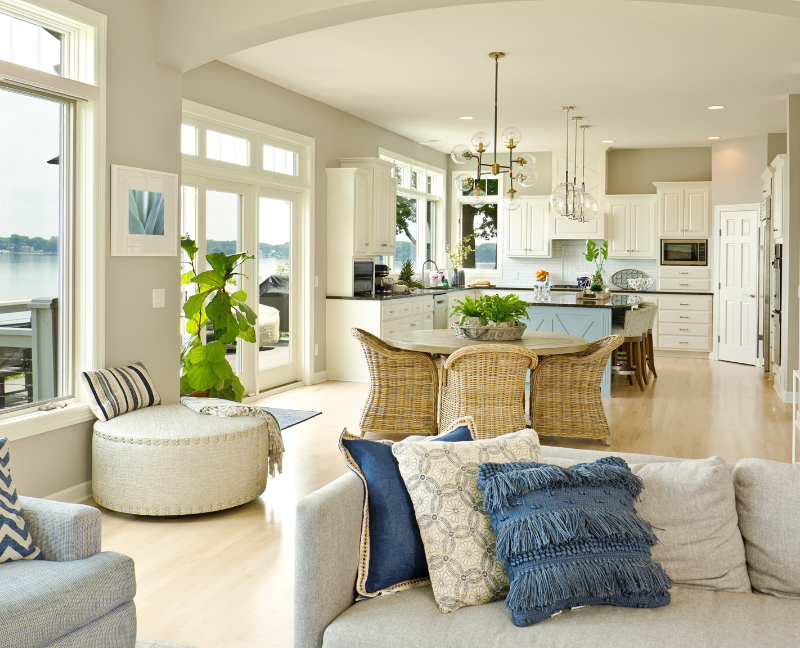
There are a lot of renovation kitchen ideas that involve substantial structural work, but most of them are centered on changing the room's design. 45% of homeowners upgrading their kitchens redesign the layout, and 43% modernize their systems. Alterations to the ceiling height and reorganization of the flooring are two examples of these modifications.
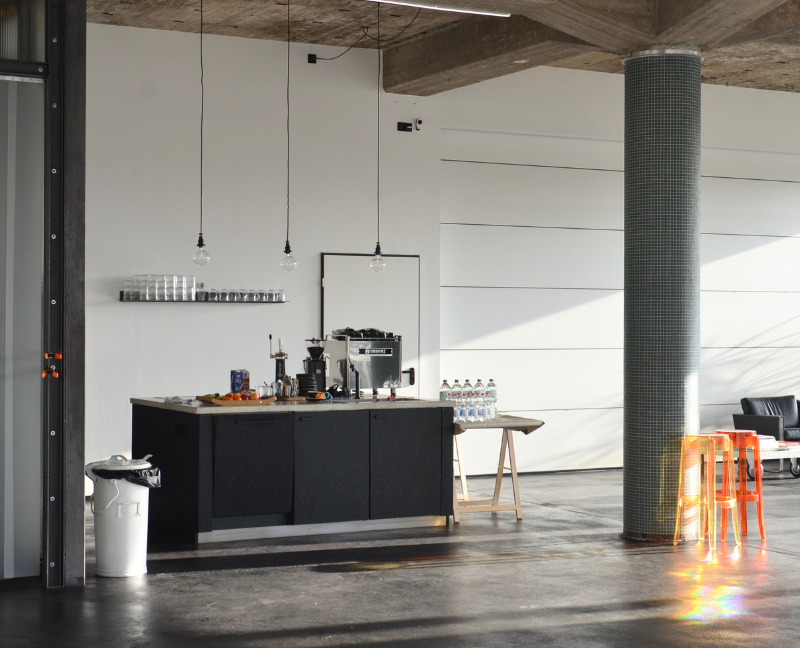
Appliances that are equipped with high-tech features are becoming increasingly popular among homeowners. Some homeowners upgrading their homes prefer home appliances connected to Wi-Fi.
In comparison, some choose devices that can be operated using a smartphone or tablet. Meanwhile, some homeowners would replace all their appliances simultaneously during a makeover rather than just a handful.

The most frequent reason given by homeowners renovating their kitchens is to meet the needs of elderly family members. A few suitable kitchen modifications for the age include rounded counters, pullout cabinets, more lighting, broad drawer pulls, and non-slip flooring.
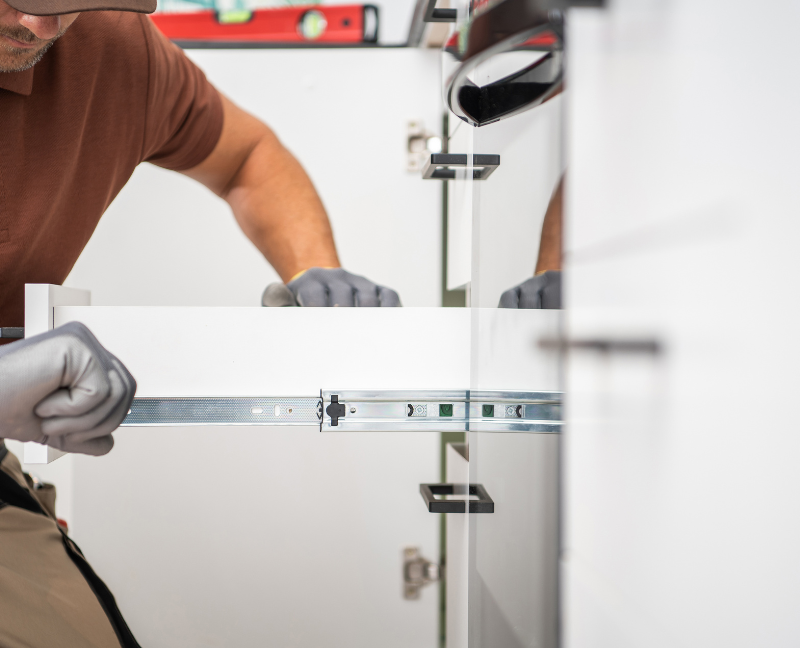
During a renovation, many homeowners change the backsplash in their kitchen. Engineered quartz is the most preferred material for backsplashes, followed by ceramic or porcelain tile. However, natural stone materials like granite, quartzite, and marble are equally popular among homeowners.
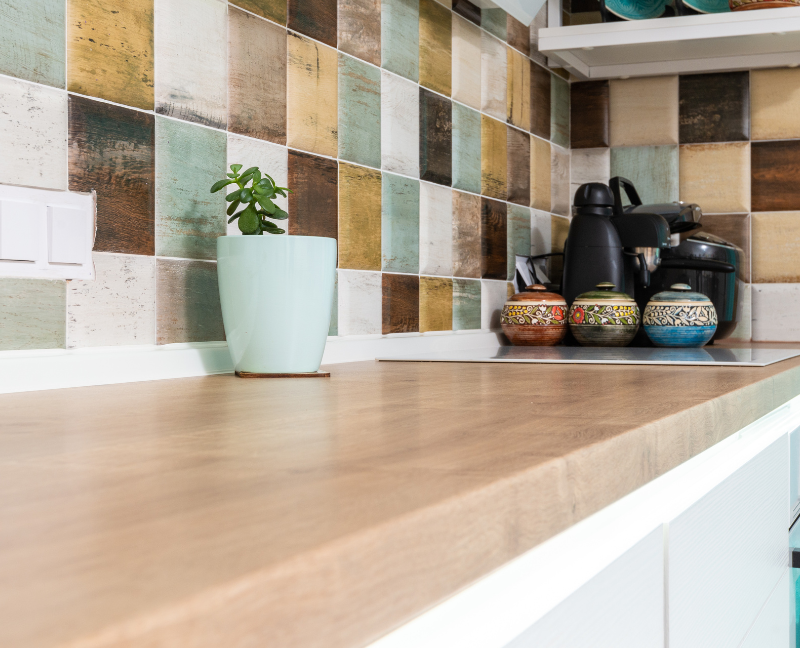
A larger kitchen island gives you more room for cooking and hosting guests, so many homeowners choose to expand their islands. Forty-two percent of homeowners remodeling their kitchens design seven-foot or longer kitchen islands.
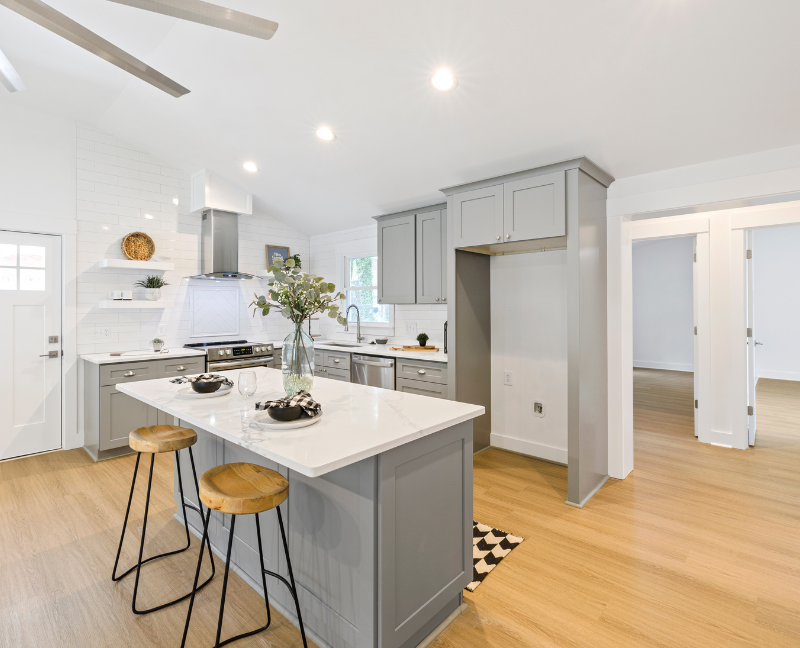
More color will be in the kitchen this year, especially on cabinets. Kitchen cabinets in wood and green are growing, but white is still the most popular. Wood tones are most famous for bottom cabinets, followed by blue for island cabinets.
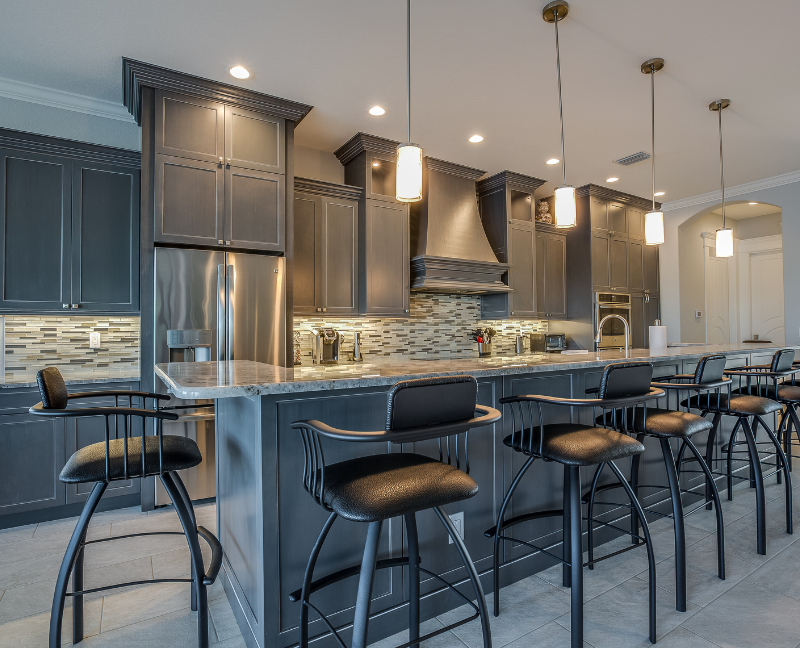
Organization is becoming increasingly important because people desire kitchens that are functional for them. Cutlery and utensil organizers, spice racks, and cookie sheet organizers are among the features that are becoming more and more popular.

Your kitchen's lighting creates a mood. Recessed lighting is still homeowners' first option when remodeling their kitchens. Some homeowners choose pendant lights, although under-cabinet lights are also trendy.
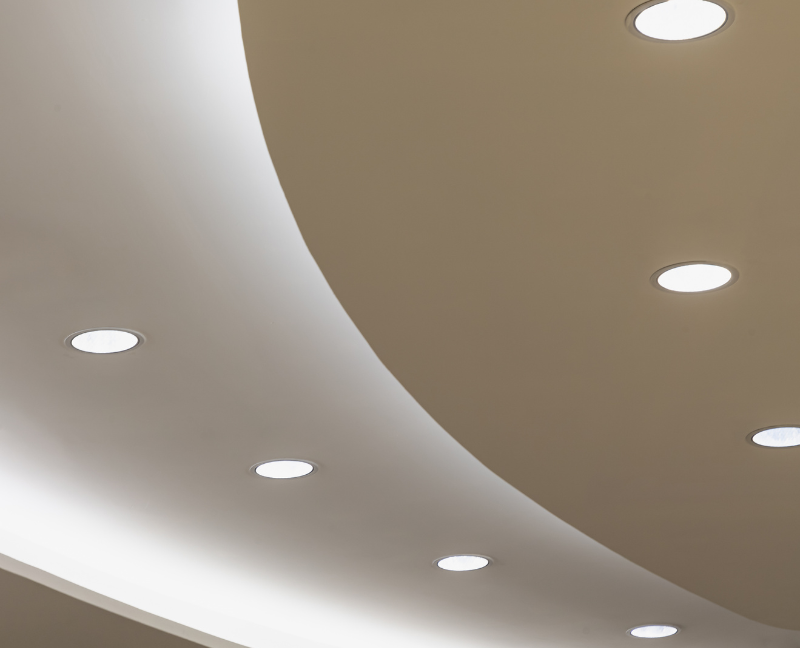
Check out these best kitchen renovation ideas to turn your kitchen into a gastronomic paradise. Elegant rustic themes to sophisticated modern designs fit any taste. Prepare to maximize the renovation kitchen ideas' beauty, functionality, and personal style.
If you want to remodel your home by taking a loan, make sure to spread payments according to your paying-off capability.
After you decide that it’s time to look into some home improvements as well as upgrading your living environment, you can do so in many ways, from bathroom repairs to adding an extension to your current space of living.
But first, let's tackle the basics.
A home improvement loan is a type of personal loan specifically used for repairs, home maintenance, and other esthetic or functional enhancements.
Loans for home renovations can be used for everything -- from minor upgrades like changing the kitchen sink to major renovations like redoing every room. For homeowners, obtaining a home repair loan is a desirable alternative since it typically has fixed interest rates and repayment schedules. While keeping up with your loan repayments, you can forecast and control your monthly financial flow.
Like other kinds of loans, you get a lump sum that you can use for renovation-related expenses, such as:
You will then repay it with a fixed interest rate over some time. That said, you have to know if borrowing a home improvement loan is what you need at the moment. It can be expensive, depending on the interest rate you'll get, but if it will improve your quality of life, it can be worth it.
Remodeling is not just a small change that is going to make you temporarily happy, but a strategic step towards raising the value of your home, especially if you are planning to sell your property shortly.
We should notice the difference when it comes to the financial side of home improvement. While decorating the home can be done without so much financial investment, some major technical improvements such as central heating could cost you significant investment.
So before signing up for a home improvement loan, figure out how much you need first. Make sure that the amount you’re going to borrow is enough to cover your estimated expenses; however, don’t go more than what you need or can afford to avoid being trapped into debt.

If you have some experience in home remodeling that would be beneficial in the sense of saving some money, while it is highly advised to hire a good tradesman and have a walk-through with him to see what needs to be done in the house.
He will be able to provide you with a quote for the job that you guys are planning to get done. It is also important to know the difference between a “quote” and an “estimate”. Quotes are a more set type of investment evaluation, with précised amounts for each part of the job, including material and labor, while estimates can only give you an approximate amount. Do not limit yourself to only one tradesman, but have at least a few of them come over and give you their offers.
Once you have offers from contractors in writing and you know how much it takes to get the job done - it is time to look for funding. Since most of us do not have substantial savings for these types of projects, we decided to go with loan providers that offer loans that are going to be put toward home improvements.
As well all know, they do not work for free, so interest will be applicable in this case. Since this is going to be an important financial decision, make sure you can afford the loan before you take one on. While there are many different types of loans available on the market, when it comes to a home improvement loan, it is typical that this type of loan is an unsecured personal loan, which means that is not secured against an asset such as your property and most of the time should be repaid within 24 to 48 Months.
For larger home improvements that need an increased amount of funding, some homeowners consider tapping into their property’s equity to fund home improvement.
When you apply, lenders will check your employment status and income. Having the necessary paperwork together in advance helps expedite the application process. Unlike a home equity loan or home equity line of credit, a home renovation loan does not require a home evaluation because there is no home equity involved.
Once you’re done selecting a lender, you must fill out an official application. While most loan providers allow you to apply online, you may need to apply in person at smaller banks or credit unions. After submitting your application, you can hear back the same day and get funded in as little as one to seven business days.
A home repair loan typically does not qualify for tax deductions for interest paid.
On the other hand, you might be able to lower your tax liability by updating your home with energy-efficient improvements. A 30% tax credit, up to $1,200 a year, is offered to homeowners who upgrade their homes with energy-efficient features including windows, doors, and central air conditioning as part of the Inflation Reduction Act of 2022, or IRA. A 30% extra tax credit is available for the purchase and installation of solar panels.
These are the basic things you need to know about home improvement loans. If you have more questions on this topic or any home-related inquiries, we are more than happy to answer them. Leave a comment or send us an email at dennis@indyhomepros.com so we can assist you!
Real estate has widely adopted sustainable and eco-friendly techniques in recent years.
From residential properties to commercial establishments, green features have proven their benefits. Sustainability improves the environment, tenants' quality of life, and long-term costs.
Determining the importance of sustainability in real estate involves both strategic investment and environmental responsibility.
Green techniques frequently result in long-term cost savings and enhanced property values. Environmental duty consists of minimizing carbon emissions and protecting natural resources.
This post discusses the growing popularity of eco-friendly and sustainable real estate characteristics, including green building methods, energy-efficient appliances, renewable energy sources, and eco-conscious architecture.
Sustainable living has grown due to environmental awareness and the desire for energy-efficient and environmentally friendly lives. Due to this paradigm shift, real estate developers, architects, and homeowners now prioritize sustainability. Sustainable building strategies reduce these negative consequences by using eco-friendly materials, minimizing energy use, and using renewable energy.
Here are the essential details you need to know about sustainable real estate;
Green building practices contain many strategies to reduce buildings' environmental footprint while promoting occupant health and comfort. These practices include energy-efficient design, sustainable materials, and others.
Energy-efficient buildings use enhanced insulation, high-performance windows, and efficient HVAC systems to save energy and reduce fossil fuel use.
Additionally, green buildings use natural ventilation, low-emission materials, and air filtration to enhance indoor air quality. Better indoor air quality improves health, productivity, and well-being.
Besides sustainable building principles, green real estate uses energy-efficient appliances and fixtures. Refrigerators, dishwashers, lighting fixtures, and plumbing fittings that use less electricity and water reduce utility expenses and environmental effects.
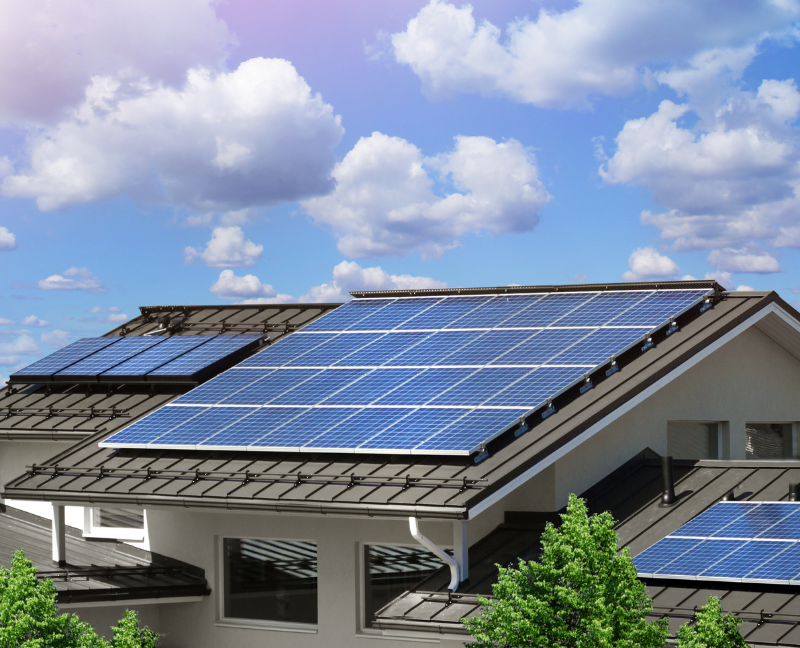
Sustainable real estate relies on solar, wind, and geothermal electricity. Buildings may use less fossil fuels and help clean up the electricity grid using renewable energy.
Low costs and generous incentives have made solar photovoltaic (PV) systems popular in residential and commercial locations. Systems that turn sunlight into electricity power homes and businesses with clean, renewable energy.
Wind turbines, geothermal heat pumps, and solar PV can generate sustainable energy on-site. Property owners can lessen their carbon footprint by investing in these systems and earning net meters and renewable energy credits.
Beyond renewable energy and energy efficiency, eco-conscious design is essential to sustainable real estate. There are several features and initiatives to reduce environmental impact and improve user comfort and well-being.
Native landscaping increases biodiversity and takes less upkeep than lawns, while green roofs and rainwater harvesting systems manage stormwater runoff and minimize water use.
Recycling and reusing materials in construction and interior design reduces waste and carbon emissions. Reclaimed wood flooring and recycled glass countertops provide character and charm while reducing environmental effects.
Together with green features, green certification, and standards are crucial to real estate projects. Several organizations and projects have set sustainable building standards for developers, architects, and homeowners.
A stage toward a more sustainable environment is the importance of sustainability in real estate. From green construction techniques to energy-efficient appliances, renewable energy sources, eco-conscious design, and green certification and standards, sustainability has many benefits.
As demand for sustainable living rises, so will green features in homes and businesses. Sustainability and green certification in real estate development and restoration projects may build healthier, more resilient communities and protect the earth for future generations.
"Less is more" provides a practical alternative in a society where distractions and clutter are widespread. The minimalist lifestyle fosters a deeper and more meaningful journey by removing excess and highlighting essential elements.
Prioritizing personal growth, relationships, and experiences over material possessions and superficial desires characterizes the minimalist lifestyle benefits.
As individuals increasingly strive to simplify and scale down their living environments, this minimalist lifestyle mirrors a broader cultural transition towards simplicity and sustainability.
If you're contemplating adopting a minimalist lifestyle, here are several reasons why you might be inclined to explore its minimalist lifestyle benefits.
Reducing the amount of things and activities you engage in is a necessary part of leading a minimalist lifestyle. This will allow you to live a life that is easier to access and less stressful. When there are fewer things to worry about and work on, you will have more time and attention to dedicate to the important things.
You can save money by becoming minimalist in a variety of ways. You can save money by purchasing fewer items that you don't need. Reducing the size of your living area is another way to reduce your housing expenses. You also require less space to store your belongings when you own fewer of them.
Minimalist living is another way to lessen its impact on the environment. You use fewer resources and make less waste when you make fewer purchases. Reducing your energy use and carbon footprint is another benefit of downsizing.
It is not enough to own fewer things to practice a minimalist lifestyle; one must also prioritize experiences over tangible goods. You can cultivate deeper ties with the people in your life and construct more significant memories if you concentrate on experiences rather than stuff.
Anxiety and stress can be brought on by feelings of being overwhelmed by clutter and mess. Make your environment more serene and calming by minimizing the amount of clutter in your life and streamlining your daily routine. This can be accomplished by reducing feelings of stress and worry and boosting your mental well-being,
If you have fewer things that could distract you, you can concentrate more on the essential things you need. This may help you become more creative and productive, ultimately allowing you to accomplish your objectives efficiently.
In addition, adopting a minimalist lifestyle can assist in developing gratitude. When you have fewer experiences and belongings, you create a greater appreciation for the things that you do have. The cultivation of a sense of gratitude and contentment in your life can be facilitated by doing this.
Conclusion
Simplifying your life, placing a higher value on experiences rather than material belongings, and decreasing your influence on the environment are all ways to make your life more satisfying and meaningful.
Therefore, if you are experiencing feelings of powerlessness due to clutter and distractions, consider having a minimalist lifestyle and observing how minimalist lifestyle benefits might improve the quality of your life.

8313 W. 10th St
Indianapolis IN 46234
dennis@indyhomepros.com
317-316-8224